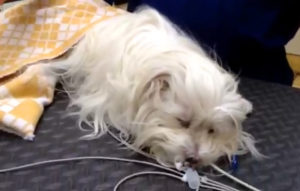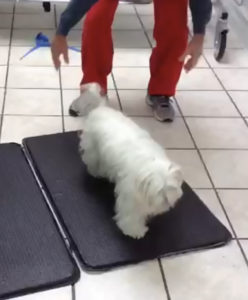Adjunctive HBOT in a case with Complete Global Ischemia (CGI)
A 7-year-old F/S canine was referred as an emergency transfer with an endotracheal tube in place. The patient had been induced with propofol after premedication with acepromazine and glycopyrolate. Tremors, twitching, and dyspnea were noted soon after the propofol was administered, and the anesthetic procedure was aborted. However, efforts to extubate the patient had resulted in labored breathing with cyanosis, so the patient was re-intubated and transported to the referral center.
Upon presentation the patient was placed on a non rebreathing system at 100% oxygen. SPO2 was measured at 99% with a pulse oximeter. IV Normosol at two times maintenance rate was initiated. An I Stat Chem 8 revealed normal glucose, electrolytes, and renal function test results. Neurologic examination revealed a recumbent patient with spontaneous respirations in sinus rhythm, with pinpoint pupils, trembling and twitching, not responsive to auditory or noxious stimuli (IMAGE 1). The history and neurologic exam were consistent with forebrain signs and elevated intracranial pressure associated with an episode of complete global ischemia (CGI). After 10 minutes on the non rebreathing system the patient was extubated. SPO2 remained greater than 90%, and the patient was placed in the hyperbaric oxygen chamber for a one-hour session of 100% oxygen at a pressure of 1.5 ATA.
Within 15 minutes after initiation of the HBOT session the patient began to sit up and chew on the cotton bandage covering the IV catheter site. The dog stopped chewing on the bandage for a minute or so every time the hyperbaric chamber operator called her name over the intercom and sternly commanded “No”.
Immediately after the HBOT session the patient was placed on the ground, and she walked across the floor (IMAGE 2). The patient was treated with IV fluids and BID one-hour HBOT sessions at 1.5 ATA for two days, then discharged home to the owner, who requested follow up outpatient HBOT.
HBOT has the potential to rapidly improve neurologic function in patients with Complete Global Ischemia resulting from a variety of causes. A discussion of pathophysiology, controlled canine studies, and clinical cases of CGI can be found in the proceedings of the 2014 ACVIM Forum (“Complete Global Ischemia (CGI) and Hyperbaric Oxygen Therapy in Small Animals”, Ronald Lyman DVM, Diplomate ACVIM).

